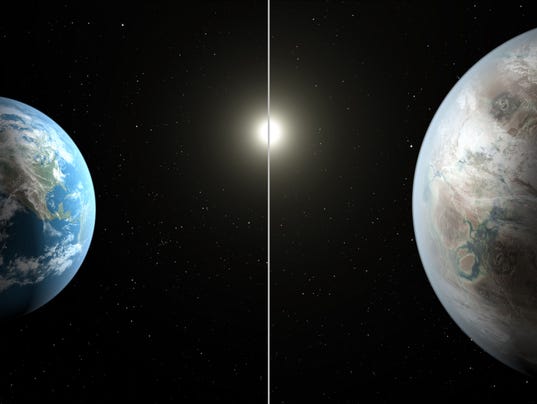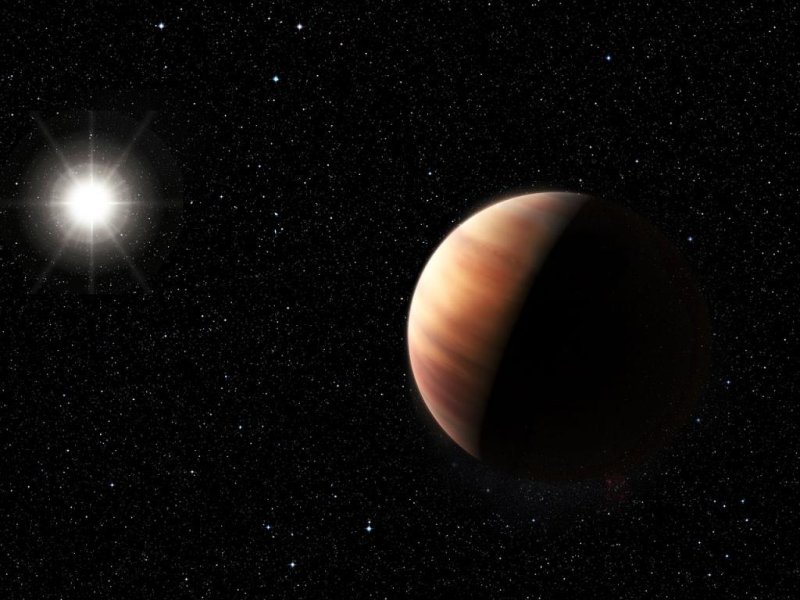 Scientists have spotted a planet much the same size as our Earth orbiting a star that closely resembles our sun, making this new world the most likely known place outside our solar system to harbor life.
Scientists have spotted a planet much the same size as our Earth orbiting a star that closely resembles our sun, making this new world the most likely known place outside our solar system to harbor life.
The newfound planet, referred to as Kepler-452b, “is the closest thing we have to another place that somebody else might call home,” Jon Jenkins of NASA’s Ames Research Center told reporters Thursday. The planet has been at just the right temperature to boast liquid water for some 6 billion years, “a considerable time and opportunity for life to arise somewhere on its surface or in its oceans,” assuming the place has all the necessary ingredients for life, Jenkins said.
NASA's Kepler spacecraft spots planet 'somebody else might call home'
Galactic assembly seen in early universe for the first time
 For the first time, astronomers in Europe have observed star-forming gas clouds in the early universe -- the building blocks of the first galaxies.
For the first time, astronomers in Europe have observed star-forming gas clouds in the early universe -- the building blocks of the first galaxies.
The faint glow of ionized carbon was spotted by the European Southern Observatory's ALMA telescope, located in Chile. To find these earliest galaxies, researchers trained the telescope deep into space, past the obvious light of more mature quasars and star-filled galaxies.
Massless particle discovered 85 years after it was theorized
 Researchers have discovered a massless particle, which was first theorized 85 years ago and thought to be a possible building block for other subatomic particles. The discovery of the Weyl fermion, conceived of by mathematician and physicist Hermann Weyl in 1929, could be a boon for electronics, researchers said. It could allow electricity to flow more freely and efficiently providing greater power, most notably for computers.
Researchers have discovered a massless particle, which was first theorized 85 years ago and thought to be a possible building block for other subatomic particles. The discovery of the Weyl fermion, conceived of by mathematician and physicist Hermann Weyl in 1929, could be a boon for electronics, researchers said. It could allow electricity to flow more freely and efficiently providing greater power, most notably for computers.
"The physics of the Weyl fermion are so strange, there could be many things that arise from this particle that we're just not capable of imagining now," M. Zahid Hasan, a professor of physics at Princeton University, said in a press release.
New species of feather-winged dinosaur unearthed in China
 A nearly complete, new dinosaur fossil has been unearthed in China, the first in its family to have unusually short feathered wings.
A nearly complete, new dinosaur fossil has been unearthed in China, the first in its family to have unusually short feathered wings.
The new species named Zhenyuanlong suni is a close cousin of the dinosaur predator Velociraptor.
Scientists said the new addition, which lived around 125 million years ago, had multiple layers of dense feathers covering both its wings and tail. Experts, however, believe the feathers are more for display instead of flying.
New Horizons Beams Back New Pluto Pics
 Signals from a spacecraft 3 billion miles away swept over Earth on Tuesday, confirming that NASA's New Horizons probe survived its history-making Pluto flyby.
Signals from a spacecraft 3 billion miles away swept over Earth on Tuesday, confirming that NASA's New Horizons probe survived its history-making Pluto flyby.
The radio signals were received by a Deep Space Network antenna in Spain four and a half hours after they were sent out from the spacecraft at the speed of light, and a full 13 hours after the probe made its close pass. But they electrified hundreds of VIPs, journalists and Pluto fans here at Johns Hopkins University Applied Physics Laboratory as if the main event had just happened.
Astronomers discover Jupiter twin around solar twin
 A team of international astronomers may have found a solar system just like ours, lending hope to researchers looking to find rocky Earth-like exoplanets in the habitable zone.
A team of international astronomers may have found a solar system just like ours, lending hope to researchers looking to find rocky Earth-like exoplanets in the habitable zone.
Using data collected by the European Southern Observatory's 3.6-meter telescope, researchers recently located a Jupiter-like gas planet orbiting a sun nearly identical to our own.
Large Hadron Collider discovers new pentaquark particle
Scientists at the Large Hadron Collider have announced the discovery of a new particle called the pentaquark.
It was first predicted to exist in the 1960s but, much like the Higgs boson particle before it, the pentaquark eluded science for decades until its detection at the LHC. The discovery, which amounts to a new form of matter, was made by the Hadron Collider's LHCb experiment.
The findings have been submitted to the journal Physical Review Letters.
More Articles...
Page 12 of 61

 Science Glance
Science Glance






























